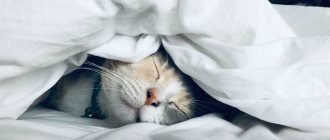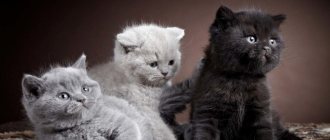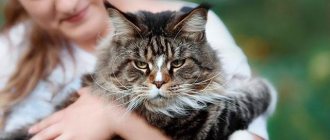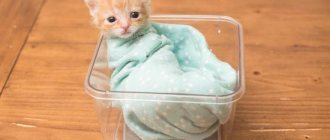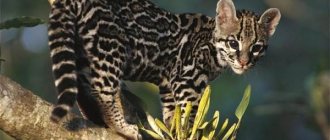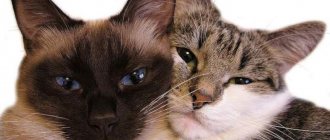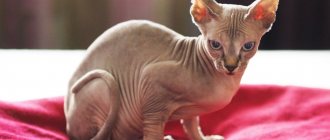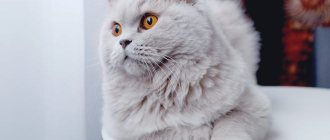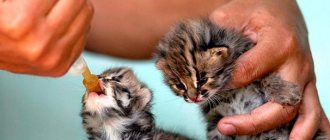History of the Bengal cat breed
Bengal cat
As is known, new breeds of domestic cats appear mainly as a result of careful selection, designed to obtain animals with the desired characteristics of the parents of different artificially created species or to consolidate the result of a natural mutation. The appearance of the Bengal cat, in fact, was the result of the persistent work of one enthusiast, who acted despite unfavorable life circumstances and the prejudices of his colleagues. The name of this purposeful woman is Jane Mill. While still studying at the University of California at Davis, a genetics student became interested in the possibility of creating a new breed by crossing Royal Siamese and Persian individuals. But the scientific supervisor considered such a research topic “frivolous”, advising us to focus on the selection of something more practical that could be of interest to agricultural or livestock farms. The idea was abandoned, but not forgotten.
In 1961, during a work trip to Thailand, Jane saw wild leopard cats for the first time and was completely fascinated by these big-eyed creatures. There, a shocked American woman learned that the existence of the species was threatened by the hunt for their unusual fur. To save at least one handsome spotted cat, she bought and brought Malaysia home, where a mongrel black cat already lived. The owner had no plans to have a common offspring, and the birth of Kin-Kin was a real surprise. The “hybrid” cat, in turn, gave birth to two kittens, but it was not possible to continue the line: the girl did not inherit the characteristic color of Far Eastern cats and had a bad character, and the boy died in a tragic accident. Kin-Kin herself, without producing any other offspring, died of pneumonia.
Bengal kitten
This could have been the end of the felinologist’s experiments, but by a happy coincidence, a litter of domestic cats and ALC (Asian Leopard Cat) males resistant to this disease was obtained at the Loma Linda University Medical Center for research on feline leukemia. Dr. Willard Centerwall, who led the project, happily placed several first-generation kittens into Jane's care. A new problem was the choice of partners for further breeding - Mrs. Mill was sure that the British, Abyssinian or other popular species had genetically weakened lines and were therefore not suitable for breeding a new breed. The solution was found after a trip to New Delhi, where she accidentally saw a spotted golden-red kitten. The bronze color and special shine of Tori's coat were passed on to descendants. Later, several more cats were brought from India to the United States for Jane, today recognized as the “Indian line” of Mau.
Many local breeders of the familiar Egyptian Mau and Ocicat were hostile to the initiative and launched a campaign against the registration of hybrids. It is unknown whether they were afraid of the uncontrolled manifestation of “wild blood” or were simply trying to prevent the appearance of spotted competitors. As a result, Bengal cats were not recognized by the authoritative The Cat Fanciers' Association for a long time, although TICA registered the first individual of the new breed back in 1983. Since 1985, Jane Mill's pets have actively participated in national exhibitions, captivating experts and spectators with their shiny coats with contrasting patterns, athletic build and natural grace.
Throughout the 80s and 90s, the creator of the Bengals continued her selective work and received several more productive lines, including those with the participation of new male leopard cats. Today, breeders call the main goals of improving the breed the purification of “genetic debris”, which manifests itself in kittens with a single color, long hair, and unwanted ticking.
Character and behavior
A wild cat, as they say, has a wild character. Their ancestors, who loved free life and independence, passed on their most striking character traits to their descendants, so the Bengal is a real bundle of energy. The bunch is wayward and capricious, but with the right upbringing it can become a completely friendly and balanced member of the family. Bengals need constant human attention and communication, otherwise they quickly run wild.
They are friends with dogs, live quietly side by side with cats of other breeds, but other pets, alas, will be under constant threat. Hunters by nature, Bengals will not rest until they catch all the fish from the aquarium, strangle the birds in the cage and get the hamster out of his house.
They love affection, but do not tolerate intrusion into the territory they consider theirs. They prefer fun games and running around the house to sitting on their hands. Very talkative: ready to “talk” to everyone who is nearby.
Does your cat like to swim?
Not really
Playfulness lasts until death, so you will have to equip your pet with nothing more or less - a play corner in the apartment, and a bigger one. And also: walk with your cat more often, giving her the opportunity to climb trees and explore the surroundings in as much detail as possible. Bengals get bored with toys quickly, so be prepared to spend money.
The Bengal is one of the most intelligent and savvy breeds, able to wait and adapt to circumstances. They quickly learn to open doors, turn lights on and off, turn the faucet handle, and even flush the toilet.
These little thieves love to hide small things that you carelessly left in plain sight. Keys, keychains, iridescent hairpins, paper bills - everything that rustles, shines and knocks immediately attracts their attention and is dragged away “in reserve.” By the way, they then prefer to tear up the papers, so hide the document first.
Bengals choose one leader for themselves, whom they will run from corner to corner like a dog. They get used to the leash and harness quickly. Children are treated with care and attention.
Bengal kittens are real little bullies, so teach them discipline from day one. Otherwise, an uncontrollable monster will grow out of a cute, restless fluffy.
Appearance of the breed
Bengal cats are medium to large in size, but are inferior to the largest domestic breeds such as the Maine Coon or Savannah.
The weight of an adult animal can range from 4 to 9 kg, height at the withers - 26-32 cm, length from nose to tip of tail - 65-100 cm. Moreover, males are much larger than females and reach their maximum size by 2 years. Cats practically stop growing after 9 months. The main distinguishing feature of the Bengal cat's exterior is undoubtedly its “wild” color; it was this feature that determined the direction of breeding work from the very beginning. Over time, a breed standard was developed and approved that covers the main traits.
Wool
The Bengal cat's coat is shorter than average (medium length is acceptable for kittens), thick, and close to the body. A characteristic difference from other breeds is their extraordinary silkiness and special “internal” shine, called glitter. The latter is inherited from wild ancestors and is extremely valued.
Color
Bengal cat face
The main requirement for the color of a Bengal cat is the clearest possible contrast between the spotted or marbled pattern and the background. The design can range from black to cinnamon, and the background should be between golden orange and ivory. Reputable breeders (for example, Jean Dakota) insist that preference should be given not to “red” Bengals, in which, as they grow older, the rosettes and stripes almost merge with the base, but to cats with a fawn background and a dark pattern.
Due to the “wild” genes, Bengal kittens have a unique color feature for domestic cats: when born bright, with a pronounced pattern, they suddenly fade by 3-4 weeks. This is explained by the fact that at this age the offspring of the Far Eastern cat begins to leave their safe shelter and without such “tarnishing” they will become easy prey for predators. This fuzzing (from the English fuzzy - blurry, indefinite) lasts about two months, that is, just by the time the kitten is purchased, it becomes attractive again. However, the final color of a cat is established much later, at 8–10 months.
The spotted pattern is more common than the marbled pattern. What distinguishes them from the usual “mackerel” color for other breeds is their location along (and not across) the body or diagonally. The shape of the spots can vary widely, the main thing is their clear outlines, while simple single ones are considered undesirable. Marble pattern - contrasting stripes whirling in a horizontal direction. A significant disadvantage of any color is the white spots - “medallions” on any part of the body. The belly is preferably light in color and the absence of spots on it is sufficient to disqualify a Bengal cat for exhibition.
Today, the officially accepted varieties are brown tabby, silver tabby, seal sepia tabby, seal mink tabby, seal lynx point and, approved only in 2013, and therefore rare blue tabby.
Adult Bengal cat with kitten
Head
Bengal on a box
The structure of the Bengal cat's skull belongs to the so-called “wild” type. It has the shape of a modified wedge, elongated rather than wide, the contours are soft and rounded. The line of the occipital part is a continuation of the line of the neck. In relation to the body it has a small, but generally proportional size.
Regarding the profile, there are differences between the American and European standard. The first assumes a strictly straight line forming a single arc from the level of the eyebrows, while the second allows for the possibility of a slight bend at the junction of the forehead and nose.
The jaws are powerful. The cheekbones are high and clearly defined. The chin is rounded, located in line with the tip of the nose. Adults may have prominent cheeks. The nose is large and wide. The whisker pads are convex.
Ears
They continue the wedge line, are characterized by a small size in relation to the head, a wide base and rounded tips (most other breeds have pointed tips).
Eyes
The eyes of a Bengal cat are large and expressive. The shape is oval, but close to round. They are spaced quite wide and have a deep seat. The color is bright and rich, most often ranging from light green to gold. Point and mink cats have shades of blue and blue from aqua to sapphire. They glow very brightly in the dark.
Bengal with blue eyes
Neck
Mmm... shrimp
Corresponds to the proportions of the head and body. Long, strong, muscular.
Torso
It has developed muscles, powerful, elongated (but not the oriental type, characteristic of orientals). The skeleton is solid and strong. A flattened or underdeveloped chest is a disqualifying fault.
Limbs
Medium length, strong, muscles developed in proportion to the general constitution of the body, wide bones. The hind ones are slightly longer than the front ones. The pads are large, round in shape, and the finger joints protrude slightly.
Tail
The Bengal cat's tail is of medium length, thick, tapering towards the end and has a rounded tip. Ringed with dark stripes or (less commonly) covered with small spots.
Description of the breed
This species appeared in 1963 in America, thanks to the crossing of an ordinary cat with a leopard, hence the characteristic spotted color of the breed. It was the color that played its role in the popularization of these cats throughout the world. Many people want to get an exotic animal right at home, but they don’t always have the courage and basic space.
The Bengal cat is an ideal option in this sense, if not for its small size, it would be easy to confuse such an animal with a wild inhabitant of the savannah. Experts note several features of this breed:
- “Bengals” are very attached to the place and people with whom they are for a long time.
- The cat's friendliness and playfulness make it an ideal gift for children.
- It is quite easy to care for her, considering that she is a cross between a leopard and a cat, she has independence and a free character.
The characteristics of this breed are very noticeable. Firstly, the head is wedge-shaped and the placement of the ears is slightly different from what we are used to. There is an opinion that these animals are aggressive due to their origin, but this is not so. They have only 15–20% of leopard genes, and they are mainly reflected in the appearance of the animal. Also, unlike their counterparts, these spotted ones adore water.
Photos of Bengal cats
Briefly about the breed
The Bengal cat is a broad-shouldered and muscular pet with a short-haired spotted or merle pattern.
The head of the Bengal is pointed, the neck is short and powerful, and the tail is of medium length.
The Bengal cat is a broad-shouldered and muscular pet.
The color of the cats resembles their leopard ancestors. The color range varies within brown shades. There are also snow and silver Bengals.
Bengal cat personality
Many potential owners are frightened by the possibility of displaying uncontrollable character traits that Bengals can inherit from wild leopard cats. It must be said that such fears are groundless if the pet does not belong to the first three generations of the hybrid. Cats F4–F7, raised in conditions of constant contact with humans, are invariably characterized by a balanced and friendly disposition. When kept in an enclosure in a nursery and lack of attention from the breeder, the kittens become wild, but this deficiency is easy to identify when meeting the kids for the first time.
Hey, keep your distance!
Bengals are very social. They easily find a common language with all household members; as for other pets, they coexist peacefully with cats of other breeds, and are often even friends with dogs. However, we must not forget that Bengal cats have extremely developed hunting instincts, so leaving them alone with potential prey is fraught with tragedy. Protection is required not only for birds and rodents, but also for aquarium fish, because, like their Asian ancestors, domestic leopards do not suffer from hydrophobia. Moreover, they really enjoy water treatments and can unceremoniously dive into a filling bath or make their way into a running shower.
Representatives of the Bengal breed (especially ladies) do not particularly favor intrusion into their personal space. No, you won’t encounter aggression in response to an attempt to “cuddle”, but too close contact makes them feel uncomfortable. It’s better to wait until the Bengal is in the appropriate mood and he himself comes to you for affection. But pets greet verbal communication with great enthusiasm and enthusiastically “keep the conversation going.” These cats have many specific sounds and intonations in their arsenal; within a few weeks you will be able to understand what most of these “phrases” mean.
But the main character trait, perhaps, should be considered incredible energy and playfulness, which persists throughout life. It should be taken into account that if there is a lack of physical activity, a bored Bengal cat can cause damage to your furniture and interior, so you should immediately provide it with a significant number of different toys and devote enough time to active entertainment every day.
Sailor cat
Bengal cat plays with snow
What determines the size and weight of Bengals?
Domestic Bengal cats owe their physical characteristics to wild, not so distant ancestors. The size of the spotted animals, called leopard cats (Prionailurus (Felis) bengalensis, abureviation ALC), approximately corresponds to the size of ordinary pets of other breeds. However, the legs are longer, and the hind legs are noticeably higher than the front ones. The external parameters of Felis bengalensis vary greatly depending on the habitat. Thus, the smallest, weighing an average of 2.5 kg, live in the Philippines, and the largest Ussuri, weighing up to 10 kilograms, live in the Russian taiga.
Accordingly, both the height and body length of Bengal cats fluctuate greatly in nature. The largest individuals can reach 95 centimeters with their tail.
When characterizing the physical characteristics of Bengals, we must not forget that their breeding involved not only species of wild cats from the subfamily of small cats, but also a whole list of representatives of other breeds. So, how big a Bengal cat grows depends on a number of factors. However, existing weight tables, which were derived as a result of many years of observations, still help to track the correctness of how much a representative of the breed should weigh at a particular age.
Dynamics of weight gain in Bengal kittens
Kittens in a Bengal litter grow quickly. Already by the beginning of the second week of life, a Bengal kitten becomes 2 times larger than those parameters recorded at birth, and this weight ranges from 70 to 120 grams. Of course, the size and body weight of a Bengal kitten depend on the physical characteristics of its parents. Approximate indicators of correct development by month are as follows:
- end of the first week: up to 250 grams;
- end of the first month of life (four or five weeks): from 400 to 500 grams;
- 3 months - about a kilogram;
– 7 months – 4 kilograms;
– 10-12 months – 4.2 – 6 kg.
The weight gain algorithm is uneven, there are the following features:
- a kitten’s growth at 2 months is much slower than before;
— having crossed the figure of 1 kilogram, growth accelerates significantly;
- at 7-9 months there is a new slowdown in weight gain, and female Bengals actively stop growing, and males continue to increase their parameters up to 2 years.
If the owner of a Bengal kitten experiences significant deviations from the norm towards lower weight, it is worth analyzing the diet of the mother (the menu of a nursing cat should contain more protein, calcium, vitamins) and the animal itself, and consult with a specialist.
The opposite situation may also be true: a kitten at 4 months has become fat, having gained the maximum weight expected for it at six months or even at 1 year. In this case, you will also need the help of a veterinarian.
Standards for weight and size of adult Bengal cats and cats
Domestic Bengals have impressive sizes as adults: males of the breed can reach 8 kg, and females - 6 kg. The height of a large animal at the withers is 40 cm, and the total length of the body with a tail is approximately 90 cm. The elongated body with amazing flexibility makes representatives of the Bengal breed graceful, which is one of the differences from other purebred pets from the cat family.
Naturally, females differ from males in their appearance and physical characteristics. The difference in weight, and, accordingly, in other parameters, is immediately noticeable. A junior cat that has reached sexual maturity, which is 8-9 months, is almost twice the size of a cat. Its paws and tail are more powerful.
Taking into account the goal - to create a pet that has the external and physical characteristics of small animals living in their natural environment, special standards were developed for the breed. The jury of exhibitions, championships and competitions takes into account, in particular, how athletic the animal is, how it holds its thick tail, the length of which should be average, what the size of the nose, ears and especially convex pads under the whiskers of this breed are.
Possible assumptions
Some felinological associations consider the following physical deviations from the ideal representative of the Bengal breed to be unimportant:
- smaller size of the cat while maintaining overall harmonious proportions (this assumption does not apply to cats);
- the cat’s cheeks are slightly larger than those required by the strict standard;
- the shape of the eyes, which are supposed to be almost round, is visualized as slightly almond-shaped;
— the difference between the length of the animal’s front and hind legs is not very noticeable.
These shortcomings may not affect the decision to award the win to a male cat if all other main parameters are ideal.
Education and training
A well-known fact is the high intelligence of Bengal cats. Natural intelligence, cunning and adaptability ensured their ancestors' survival in the wild, and houses provide a powerful foundation for learning interesting tricks. They can follow simple commands and fetch thrown objects (often using not their teeth, but their dexterous front paws). The observation and intelligence of Bengals means that without any effort on the part of their owners, they learn to use switches, open latches on doors, flush the toilet, and even turn off the taps.
Bengal cats master the rules of using the toilet quickly and without problems, but they like to dig deep holes, so it is recommended to ensure that the litter level is always high enough.
Other notes to keep in mind
A Bengal's weight can also affect how well a Bengal does in the home because of what Bengal cats like to play with. Their toys can determine how much effort and energy is burned during play, as well as whether damage to the home or its contents may be caused while the cat plays.
Additionally, since they typically reach the size of a normal house cat, strangers may feel more comfortable around the cat. Someone unfamiliar with the breed may try to adopt and keep a Bengal cat, treating it like a normal house cat. But this active breed usually prefers a specific or sometimes specific person(s) and may be surprised, fearful and/or aggressive when in contact with that stranger.
Because the weight of Bengal cats affects their movement and development, it is also important to consider these characteristics and physical condition when learning about and interacting with the breed. Remember, how much a Bengal might ultimately weigh may influence a potential owner's decision.
Care and maintenance
Who is there?
A pleasant surprise for owners will be the low maintenance requirements of Bengal cats. The peculiarities of the wool prevent severe tangling; it is enough to use a special combing mitt or rubber brush once every two or three days. It is recommended to trim the claws by 2-3 mm once or twice a month. Of course, cats with amputated claws are not allowed to participate in exhibitions.
It is advisable to brush your teeth with a special paste from time to time. Ears must be carefully treated when dirt appears. Washing a cat that loves water is easy. The main thing is to do this not too often (but, of course, after each walk) and using veterinarian-approved products.
Recommendations for feeding Bengals do not differ from accepted standards. The best option is premium industrial feed, which maintains an ideal balance of nutrients, vitamins and microelements. They should not be combined with other foods. A natural diet, if you are a supporter of it, should consist of 80-85% meat (chicken, veal, rabbit, lamb) and offal. Please note that dishes from the host’s table can cause serious problems with the gastrointestinal tract.
Bengal cats prefer fresh running water, so it is better to immediately purchase a special “fountain”.
Where to buy a purebred cat
When buying a kitten through an advertisement in a newspaper or the Internet, at a market or a pet store, there is a risk of acquiring a pet that is only approximately similar to a true Bengal, which in the future can turn into an ordinary yard cat.
This breed is quite rare in the Russian Federation. Breeding Bengals, due to genetic characteristics and the low number of necessary breeding material, will not be cheap.
So where to look for a Bengal so that it turns out to be real and meets the clear requirements of the breed? The best option is a cattery or breeder registered in the Russian Union of Cat Clubs. A conscientious breeder will not hide anything. It will not be difficult for him to demonstrate documents certifying the pedigree, and will be able to show at least one parent of the kitten.
An important factor is the cost of a Bengal cat. Selling at a reduced price will most likely turn out to be a deception, and instead of a real Bengal, a mestizo may be slipped in.
At the time of purchasing a Bengal cat, the breeder must provide documents for the animal:
- veterinary passport indicating the vaccination and deworming performed;
- pedigree (or kitten card), so that in the future you can get a pedigree from the club.
Health and diseases of the Bengal cat
The comparative youth of the breed and the presence of strong “wild” blood make it possible to state the good health of Bengal cats that grew up in normal conditions. The only weak point is the stomach, but a balanced diet easily solves this problem.
I want too!
Bengal is sunbathing
Why monitor the development of newborn kittens?
The weight of kittens is an indicator of their health.
Kittens can lose weight for the following reasons:
- congenital and acquired diseases;
- parasite infection;
- improper diet;
- breed or genetic abnormalities.
In order to timely identify deviations from the norm of nutrition and possible diseases, the owner of a Bengal cat is recommended to compare the kitten’s weight with the norms daily during the first weeks of life. In the future, the frequency of weighing can be reduced to 2 times a week.
Be sure to read:
The Egyptian Mau is a short-haired cat breed with a spotted coat and an outgoing personality.
How to choose a kitten
Bengal cat on owner's lap
Let us remind you once again: the Bengal cat is an elite, and therefore expensive, breed. You should not look for advertisements for the sale of kittens on random sites or, especially, buy an animal at the “bird market”. Only reliable nurseries or breeders with an excellent reputation can guarantee that your pet will be a real Bengal with a reliable pedigree!
When purchasing a kitten, pay attention to
- registration documents, pedigree and the generation indicated in it (optimal indicator F4-F7);
- age – a responsible breeder does not offer buyers kittens younger than 10-12 weeks;
- weight – at this age, a normally developing baby weighs about a kilogram;
- playfulness - a healthy animal should never be lethargic;
- contact - small Bengals must be accustomed to being handled, otherwise you risk getting a wild pet;
- clean and clear eyes, no runny nose or signs of diarrhea;
- documents on vaccination;
- the condition of the coat and the absence of visible color defects (important if the Bengal cat is planned to participate in exhibitions).
Briefly about the breed.
The most important feature of Bengal cats is their color, which is very similar to leopard print. Weight is close to that of a normal domestic cat. But having long legs makes a difference. Domestic cats are easily inferior to Bengals in this regard. The length of the cat is approximately 0.5-1.0 meters. Weight also has almost no restrictions and ranges from 3 to 7 kg on average. The breed takes root equally well in the desert and forests.
The nature of the animals is quite peaceful and flexible. Some habits resemble the habits of a dog. For example, a Bengal will have no problem bringing a toy thrown into the distance; he likes to hide things that are important to him, just as a dog hides bones far away for a treat if food is tight.
The cat tries to live peacefully with all family members, but considers one to be the owner. As a rule, the one who enjoys authority with the animal. Like most cats, it can also be mischievous - tear something to shreds, make loud noises during its displeasure or hunger. And the voice, by the way, is very different from the meowing of an ordinary cat. Scientists have accurately determined that the Bengal cat's voice is much louder.
The animals are very similar in color to tigers. Yellow color has a wide spectrum, depending on the habitat. A pale yellow tint is possible; there are also bright yellow inclusions; individuals with a red-yellow color are less common. These cats look special; the color scheme gives them some exoticism. Often yellowness is the main background against which a pattern of dark colors appears in the form of rosettes or solid spots. Dark horizontal stripes are visible on the neck and back of these cats.
Photos of Bengal kittens
Kitten weight table by age
The weight of a cat at each age should correspond to the norm:
| Age | Average breed weight |
| First week of life | 0.07-0.12 kg |
| 1 month | 0.4-0.5 kg |
| 2-3 months | 0.5-2.4 kg |
| 4-5 months | 2.7-3.6 kg |
| 5-6 months | 2.9-3.9 kg |
| 7 months | 4 kg |
| 8-9 months | 4.1-6 kg |
| 10 months - 1 year | 4.2-6 kg |
How much does a Bengal cat cost?
The price of purebred Bengal kittens in Russian nurseries starts from 15,000 rubles and can reach 150,000 rubles.
The specific figure depends on the pedigree and color. Rare and therefore the most expensive are, perhaps, blue tabby kittens. In addition, each animal is assigned a specific class based on expert assessment:
- pet class - the so-called “pets for the soul”, due to strong deviations from the standard, are not allowed for breeding and exhibitions, cost - from 15 to 30 thousand rubles;
- breed class - animals with minor deviations from the standard, cost - from 30 to 40 thousand rubles without the possibility of breeding and 60-70 thousand if you want to obtain such a right;
- show class is the elite among the elite, such cats are recognized as promising for exhibitions, therefore their cost starts from 50 thousand rubles without the possibility of breeding and from 80,000 with it.
What does the price depend on?
First of all, the main component of prices is the pedigree of the cat ; the more intense the color of the leopard, the higher the price. The age of the cat also plays an important role. Kittens are much more expensive than adults. This is due to the fact that it is easier to train a kitten and bring it closer to its way of life.
It is worth saying that the kitten is ready to move to a new place at the age of 3-4 months, not earlier. In order to avoid problems in the future, it is necessary to conclude a purchase and sale agreement between the seller and the breeder; along with the agreement, the buyer receives all relevant documents, including a pedigree (if any).
The price also largely depends on the class of the animal; the lower the class of compliance with all parameters, the lower the cost. The class is determined by several parameters, such as color, breeding stock, difficulty of care, health, and so on.
What to do if your Bengal begins to gain weight poorly
Having noticed deviations in weight gain, you should determine the reasons for this.
Bengals are one of the cat breeds that lead an active lifestyle.
A few common reasons:
- Poor nutrition. Underweight occurs if the kitten is malnourished or does not receive enough nutritional components. Make sure that the kitten eats 6 times a day and has constant access to clean drinking water.
- Refusal to eat. This problem especially often occurs among owners who purchased a kitten from a breeder. The pet may already be accustomed to a certain food and refuse to eat a new one. In this case, you should transfer the kitten to a new food gradually.
- Stress. Sudden changes in environment and other factors can provoke stress. When stressed, kittens may refuse to eat. As a rule, adaptation takes from a couple of days to a week, after which the pet begins to eat normally and gain weight again.
- Diseases. If a Bengal eats properly, but still does not gain weight well, this may indicate diseases of the digestive system. In this case, you should definitely show your pet to a veterinarian.
- Parasites. Weight loss may indicate the presence of worms. Prevention against parasites should be carried out every six months starting from three weeks of age. For kittens, a suspension is used: it is easier to administer into the body.
What can I do to prevent my Bengal from gaining enough weight?
Of course, nature dictates that this breed of cat has healthy growth and heavy weight. However, if the animal is not cared for and cared for from birth, it will be difficult for it to meet the standards. Therefore, breeders or owners who give birth to Bengal kittens are required to adhere to certain rules.
These include:
- You should measure your kitten's weight every day to track how many grams he has gained. After two weeks of their life, this control can be reduced to once every three days;
- If small animals are not gaining weight well, then you should monitor the nutrition of the nursing mother. It must be of high quality and balanced. If the cubs still do not grow well, then the female should add more proteins and vitamins to the diet;
- If this point is also fulfilled, and the kitten is not gaining weight well, then you urgently need to show it to the veterinarian. If there is a need, he will prescribe the necessary treatment;
- When the kitten loses weight, you can gradually feed it with special baby food for kittens.
See also what food is suitable for Bengal cats.
This is all that concerns the first months of a kitten’s life. And if you have bought yourself a little Bengal who has already gained good weight, then you just need to provide him with high-quality and healthy nutrition, which will maintain not only his weight and appearance, but also his health.
And if you notice any changes in his behavior, appearance or well-being, then immediately contact an experienced specialist.
If the kitten is not gaining weight well
Next, we will talk to you not about a tiny newborn pet, but about one that has already reached three months of age. So, if the owner has acquired a Bengal cat, and it is not gaining its body weight well or, on the contrary, is losing it, what to do?
There are some reasons why all of this might be happening:
- The kitten may not like the new food. It happens that a breeder’s animal ate certain foods, but now, having tried something else, it may refuse such food. Therefore, it is worth finding out what kind of food the Bengal used to eat and, if possible, then switch it to his favorite treat;
- Parasites may be the cause. Be sure to take prophylaxis against worms. Consult a specialist about this;
- various diseases. If neither the first nor the second helped the kitten gain a certain weight, then it is worth showing him to the veterinarian, perhaps he has some kind of disease that prevents him from gaining body weight correctly.
In principle, Bengal cats are always healthy and beautiful. If you treat your new family member responsibly, then problems with his weight, height and health should not arise.
When young furry creatures appear in the house, a responsible owner, even if he is not a breeder, carefully monitors their development. The owners observe how actively they suck the cat. Their curiosity, eye condition and, of course, weight matter. It often happens that with a multiple litter, the last kittens are born very weak and do not survive even a few days. The first fluffies born are the strongest. They also gain weight faster. So, let's find out how young fluffies gain body weight.
British cats weight
Answer: The normal weight of a British cat should be 5-8 kg. Maximum weight is reached by 4 years of age. Cats usually weigh less.
Answer: at three months, on average, a British kitten weighs 1.5 kg-2 kg. However, weight depends on gender - cats are smaller than cats, on heredity - how large its parents are, on nutrition, diseases, etc. Find out what the kitten was fed in the nursery. Sometimes, with proper nutrition, you can correct the mistakes made in growing, and your kitten will gain the required weight.
4. I now have an excellent British kitten, 3 months old. Tell me how much should it weigh? And how can I find some suitable table for further weight control and development?
Answer: British cats can vary in weight by almost two times. In addition, cats weigh more than cats. Here are the average data: 1 month – 0.5-0.7 kg 2 months. – 1.2-1.5 kg, 4 months. – 2 kg, 6 months. – 3 kg, 9 months. – 4 kg, 12 months. – 5 kg, 2 years – 6 kg.
5. My cat will soon be 3 months old, but he is very thin, about 1.2 kg, we gave him deworming liquid yesterday, tell me, how soon will he start gaining weight and how much should he weigh at 3 months?
Answer: If your cat has a normal appetite, then there is nothing to worry about. At 3 months, kittens weigh about 1.5 kg. The most important thing is to establish proper balanced nutrition and daily routine. Be sure to keep an eye on your stool. If everything is in order, then the weight will return to normal.
Answer: if the kitten is a cat, then it’s fine. It will be a big cat. If it's a cat, then it's too much. Perhaps you are overfeeding her?
7. Please help, I have a British cat, she is 7 months old, she x
Source
